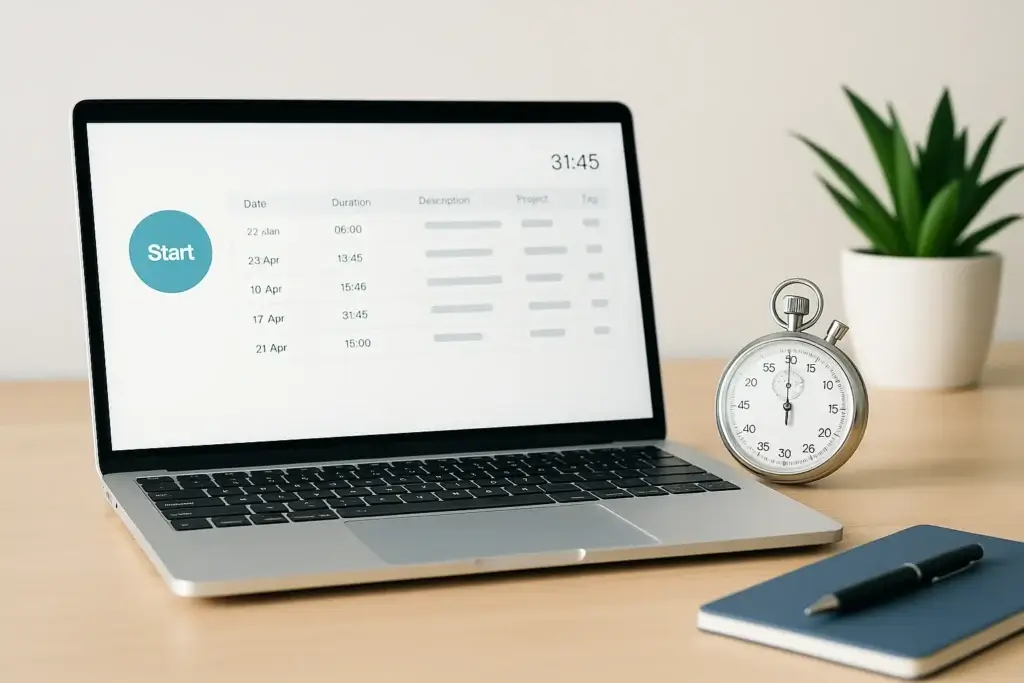Why Clockify lacks BCEA overtime & PAYE exports
If you need a time-tracking tool that lets unlimited users punch in hours for free, Clockify still ranks near the top of most “best free tracker” lists—and for good reason. It covers the basics (timer, manual entries, timesheets) without capping projects or seats. That alone makes Clockify attractive for cash-strapped teams or freelancers just starting out. Beyond that, its paid tiers unlock scheduling, forecasting, GPS, screenshots, and other power features, so you can stay within one ecosystem as your company grows. TechRadar even calls Clockify the “best free time-tracking app” of 2025, highlighting its generous forever-free plan and cross-platform reach.
Managers like the fact that permissions are per-role, exports land in PDF/CSV/Excel, and an API exists for deeper integration. On the flip side, the interface can feel clunky next to newer rivals, and payroll integrations are glaringly absent. Still, if you want something dependable, inexpensive, and familiar, Clockify deserves a long look.
Quick Verdict at a Glance
Overall score: 7.2/10
Best for: Small and mid-sized teams that need simple time capture plus solid reports
Free plan: Yes—unlimited users, unlimited projects
Major plus: Feature-rich reports you can slice every which way
Major minus: No native payroll link; UI needs a facelift
In short, Clockify nails the essentials but stumbles on all-in-one ambitions. If you can live without built-in payroll and a slick interface, the price-to-value ratio is hard to beat.
Plans & Pricing Breakdown
Clockify offers one generous free tier and four paid options billed annually: Basic ($3.99/user), Standard ($5.49/user), Pro ($7.99/user), and Enterprise ($11.99/user).
Free
Unlimited users, projects, and time entries
Timesheets, kiosk mode, Pomodoro timer
Basic reports
Good enough for freelancers or tiny teams who only need to track hours.
Basic
Adds break tracking, invoicing, and attendance approvals
Customizable exports and project templates
Ideal when admin tasks pile up and accuracy matters more
Standard
Unlocks targets & reminders, manager role, historical rates
Best for service agencies that bill different hourly rates per phase
Pro
Introduces scheduling, forecasting, expenses, and GPS
Perfect if you must plan capacity weeks ahead and control costs
Enterprise
SSO, audit logs, custom subdomains
Geared toward large orgs that must tick every compliance box
All tiers let you pay monthly (slightly higher) or annually (cheaper), and each upgrade includes a free 30-minute onboarding session—handy if you’re rolling out Clockify to dozens of employees at once.
Hands-On with the Core Features
Time Tracking Basics
Starting a timer is as simple as pressing the play button, assigning a project, and stopping when you’re done. You can also enter time manually, round it for payroll later, or mark entries billable/non-billable. For workers on-site without smartphones, you can set up a kiosk tablet where everyone clocks in with a PIN.
While tracking is accurate down to the second, switching between tasks without stopping the timer is impossible unless you’re in kiosk mode—a small but annoying quirk.
Reporting Powerhouse
Here’s where Clockify shines. Build reports by client, project, tag, or month; export them to PDF, CSV, or Excel; and even share live dashboards. Managers can make “team reports” to see capacity, overtime, or time-off balances in a blink. Expense reports are equally flexible, grouping costs by team, category, or note. Overall, reporting earns a solid 10/10 on most review sites.
Scheduling & Capacity Planning
Schedules live only in a weekly grid view—no daily layout. Copying shifts from Monday to Tuesday for the same employee isn’t possible; you’ll have to drag blocks manually. On the bright side, capacity bars show exactly how close each person is to full utilisation, so overtime risk jumps out at you.
Clockify on Mobile
Employees get almost a mirror image of the desktop: timer, timesheet, calendar, and expenses. Admins, however, lose key tools—no scheduling, limited filters on reports, no client management, and no invoice sending. The workaround is to load the normal web app in a mobile browser, which is fully responsive but slightly fiddly with small icons. For frontline staff who simply need to punch in and out, the mobile app is fine. For admins, it’s half a solution.
Where It Shines
Unlimited free users – Rare among name-brand trackers
Granular reports – Drill down by any field without Excel pivots
Flexible exports – PDF, CSV, Excel, API, you name it
Cross-device sync – Mac, Windows, Linux, iOS, Android, browser extensions
Simple interface for workers – A teen can figure it out in minutes
Where It Falls Short
Aging UI – Forms and menus feel early-2010s
No built-in payroll – You’ll need manual CSV uploads to Gusto or Xero
Basic task management – No subtasks, comments, or file attachments
Single weekly scheduler view – Hard to see the big picture
Mobile admin gaps – Creating shifts or approving reports requires the web app
Clockify vs Shifton: Which Time Tracker Fits You?
| Feature | Clockify | Shifton | Why It Matters |
|---|---|---|---|
| Free plan seats | Unlimited | Up to 50 | Bigger firms can test without friction |
| Scheduler views | Weekly only | Day, week, month, timeline | Day view helps avoid shift collisions |
| Payroll link | CSV export | Native integrations to 20+ payroll APIs | Saves hours every pay period |
| GPS & geofencing | GPS yes, geo-fence roadmap only | Both live | Stops buddy-punching at the door |
| Chat tool | None (external Pumble) | Built-in messaging | One less app to juggle |
| UI design | Functional but dated | Modern, mobile-first | Adoption rises when software looks fresh |
| Pricing (Pro tier) | $7.99/user | $6.50/user | Lower cost for advanced features |
If headcount is tiny and you mainly need timesheets, Clockify wins on price—free is tough to beat. When your operation demands smarter scheduling, auto-payroll sync, or in-app chat, Shifton takes the crown and still costs less than Clockify’s Pro tier. Either way, migrating later is painless because both platforms export standard CSV files.
Security, Support & Integrations
Security: 256-bit SSL, ISO 27001, SOC 2 Type II, two-factor auth. Voice or face ID are missing, but role-based permissions are thorough.
Support: 24/7 email, chat, phone. Average first response under an hour, even for complex API questions.
Integrations: Native links with Jira, Asana, Trello, QuickBooks (reporting/invoicing only), and 20+ other productivity apps. QuickBooks users report sync glitches—average rating 2.2/5—so test in a sandbox before going live.
API: Full REST API lets you build custom bridges, but you’ll need dev time.
Final Verdict
Clockify packs an impressive punch for a product that still offers unlimited free seats. Its timer, reports, and exports work flawlessly, and paid tiers add enough muscle—GPS, expenses, scheduling—to satisfy most SMBs. The downside? An outdated interface, no true payroll module, and clumsy mobile admin tools.
For lean teams tracking hours on a shoestring, Clockify remains a smart pick in 2025. For growing businesses that crave polished scheduling, real-time chat, and direct payroll sync, Shifton edges ahead on both features and price.
Either way, start with the free Clockify plan, run it alongside Shifton’s free trial, and let your managers and frontline staff vote. Whichever platform makes time tracking invisible—rather than another chore—will pay for itself many times over.

 English (US)
English (US)  English (GB)
English (GB)  English (CA)
English (CA)  English (AU)
English (AU)  English (NZ)
English (NZ)  English (ZA)
English (ZA)  Español (ES)
Español (ES)  Español (MX)
Español (MX)  Español (AR)
Español (AR)  Português (BR)
Português (BR)  Português (PT)
Português (PT)  Deutsch (DE)
Deutsch (DE)  Deutsch (AT)
Deutsch (AT)  Français (FR)
Français (FR)  Français (BE)
Français (BE)  Français (CA)
Français (CA)  Italiano
Italiano  日本語
日本語  中文
中文  हिन्दी
हिन्दी  עברית
עברית  العربية
العربية  한국어
한국어  Nederlands
Nederlands  Polski
Polski  Türkçe
Türkçe  Українська
Українська  Русский
Русский  Magyar
Magyar  Română
Română  Čeština
Čeština  Български
Български  Ελληνικά
Ελληνικά  Svenska
Svenska  Dansk
Dansk  Norsk
Norsk  Suomi
Suomi  Bahasa
Bahasa  Tiếng Việt
Tiếng Việt  Tagalog
Tagalog  ไทย
ไทย  Latviešu
Latviešu  Lietuvių
Lietuvių  Eesti
Eesti  Slovenčina
Slovenčina  Slovenščina
Slovenščina  Hrvatski
Hrvatski  Македонски
Македонски  Қазақ
Қазақ  Azərbaycan
Azərbaycan  বাংলা
বাংলা 

